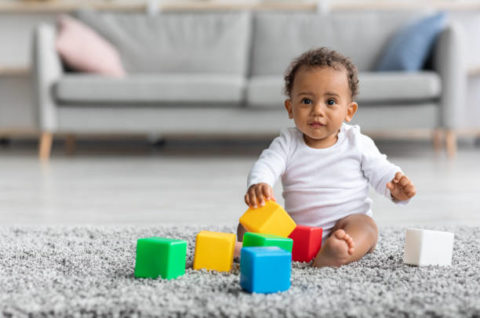
Understanding and Nurturing High-Needs Babies
December 13, 2023
How to Begin Teaching Babies
February 20, 2024Safety Tips and Childproofing Hacks for your Home

Welcoming a toddler into your home is a joyous occasion, but it also comes with the responsibility of ensuring a safe and secure environment for your little explorer. As toddlers begin to crawl, walk, and interact with their surroundings, childproofing becomes a crucial aspect of creating a toddler-friendly home. In this comprehensive guide, we’ll explore essential safety tips and practical childproofing hacks to transform your living space into a haven that nurtures your toddler’s curiosity while keeping them out of harm’s way.
Assessing and Securing Living Spaces:
- Mindful Furniture Arrangement: Begin by arranging furniture with your toddler’s safety in mind. Secure heavy furniture to the wall to prevent tipping, and avoid placing items like bookshelves or heavy decor within reach of curious hands.
- Covering Sharp Edges and Corners: Toddlers are prone to bumps and falls, especially as they become more mobile. Soften the impact of potential collisions by using corner guards on sharp edges and corners of furniture. These can be easily attached and provide an extra layer of protection.
- Securing Windows and Balconies: Install window guards or window stops to prevent accidental falls. Ensure that blinds have cordless designs to eliminate strangulation hazards. If you have a balcony, use safety netting or guards to create a barrier that keeps your toddler from reaching dangerous heights.
- Gating Stairways and Hazardous Areas: Stairways pose a significant risk to toddlers. Install safety gates at both the top and bottom of staircases to prevent falls. Additionally, use gates to restrict access to areas with potential hazards, such as kitchens or home offices.
- Securing Heavy Appliances: Large appliances like refrigerators and ovens can be a tipping hazard. Secure them to the wall or floor to prevent accidental tipping. This precaution is particularly important in earthquake-prone areas.
Childproofing Essentials:
- Outlet Covers and Plug Protectors: Electrical outlets are a magnet for curious fingers. Cover all accessible outlets with safety plugs or outlet covers to prevent the risk of electric shock. Be sure to choose designs that are not easily removable by small hands.

- Cabinet and Drawer Locks: Toddlers love to explore cabinets and drawers, often discovering items that pose a danger. Install childproof locks on cabinets and drawers in the kitchen, bathroom, and any other areas with potential hazards, such as cleaning supplies or sharp objects.
- Safety Latches for Appliances: Many household appliances, such as ovens and dishwashers, have doors that can be opened by small hands. Use safety latches to secure these appliances, preventing access to hot surfaces and potential dangers.
- Cord Management: Long cords on blinds or curtains can pose a strangulation risk. Use cord wind-ups or tie cords high out of reach to eliminate this hazard. Additionally, manage other cords, such as those from electronic devices, to prevent tripping.
- Eliminate Small Choking Hazards: Conduct a thorough sweep of your home to identify and remove small objects that could pose a choking hazard. Items such as small toys, coins, or small parts from games should be kept out of reach or stored securely.

Creating Safe Sleep Spaces:
- Safe Cribs and Bedding: Ensure that your toddler’s crib or bed meets current safety standards. Avoid using soft bedding, pillows, or plush toys in the crib, as these can pose suffocation risks. Use fitted sheets and ensure that the mattress is firm.
- Anchor Furniture in the Bedroom: Just as in other areas of the home, anchor furniture in the bedroom to prevent tipping. This includes dressers, bookshelves, and any other large items that could potentially be climbed on.
- Nightlight for Comfort and Visibility: A nightlight in the bedroom provides a comforting glow and helps parents navigate the space during nighttime visits. Choose a soft, warm light that won’t disrupt sleep but provides enough illumination for safety.
Bathroom Safety Measures:
- Anti-Slip Mats in the Bathtub: The bathroom can be a slippery space. Use non-slip mats in the bathtub to prevent slips and falls. Additionally, consider installing a spout cover to protect your toddler from accidental bumps during bath time.
- Lock Away Medications and Toiletries: Keep all medications, vitamins, and toiletries out of reach or locked away in cabinets. Childproof locks on bathroom cabinets are essential to prevent accidental ingestion of harmful substances.
- Adjust Water Heater Temperature: Lower the temperature of your water heater to prevent scalding. Toddlers are particularly vulnerable to burns, and adjusting the water temperature ensures that bathwater and sink water are at safe levels.
Safety in the Kitchen:
- Stove and Oven Knob Covers: Toddlers are naturally curious and may be drawn to the knobs on stoves and ovens. Install knob covers to prevent accidental ignition or tampering with hot surfaces.
- Secure Heavy Appliances and Utensils: Heavy kitchen appliances, such as microwaves and blenders, should be secured to prevent tipping. Additionally, store sharp utensils and tools in locked drawers or high cabinets.
- Childproofing the Refrigerator: The refrigerator can be an enticing place for little ones. Use appliance latches to secure the refrigerator door, preventing access to potential choking hazards or spilled liquids.
Outdoor Safety Precautions:
- Fence the Yard: If you have an outdoor space, ensure that it is properly fenced to prevent your toddler from wandering off. Check for any gaps or openings that could pose an escape route and address them promptly.
- Choose Safe Outdoor Play Equipment: When selecting outdoor play equipment, prioritize safety. Ensure that swings, slides, and other structures are age-appropriate and free from sharp edges or potential pinch points.
- Supervision During Outdoor Play: Always supervise your toddler during outdoor play. Even in a secure backyard, it’s essential to keep a watchful eye on your little one to prevent accidents and address any potential hazards.
Staying Informed and Adapting:
- Stay Informed About Recalls: Regularly check for product recalls related to child safety. Stay informed about potential hazards and promptly address any items in your home that have been recalled.
- Adapt as Your Toddler Grows: Childproofing is an ongoing process. As your toddler grows and gains new skills, reassess your childproofing measures. Adjust safety gates, move hazardous items to higher shelves, and continue to adapt your home to meet the changing needs of your child.

Creating a toddler-friendly home involves a combination of vigilance, preparation, and practical adjustments to ensure the safety and well-being of your little one. By implementing these safety tips and childproofing hacks, you can transform your living space into a haven that nurtures exploration and curiosity while providing a secure environment for your toddler to thrive. Remember, each child is unique, so be observant, stay proactive, and enjoy the journey of creating a safe and loving home for your growing family.
Create a learning area, with books for babies, soft toys, infant books, etc. Check out the early learning stuff from Learning Time. The A+ Program from Learning Time has all the materials that you would need to get your toddler started on the journey of early learning.




